A Framework for the Development of Wetland for Agricultural Use in Indonesia
Abstract
:1. Introduction
- high pests and diseases threat [12],
- a high water table for extended periods (prone to flooding) [13],
- a low pH of 3 to 4.5 [12],
- pyrite-affected acid sulfate soils [15],
- high concentrations of toxic elements such as iron (Fe), aluminium (Al), sulphur (S), and sodium (Na) [15], and
- deficiencies in nutrients such as phosphorus (P), potassium (K), zinc (Zn), copper (Cu), and boron (B) [12].
2. Framework Development
- Characterization of land and problem of development
- Analysis of historical development and lessons learned
- Technology development
- Optimization of development
3. Characterization of Swamplands in Indonesia
- Shallow swamp or embankment (Lebak pematang): Land on a natural levee with relatively high topography and a shallow or short inundation.
- Deep swamp (Lebak dalam): Land located far off the coast, in a basin, that is continuously and deeply inundated.
- Mid swamp (Lebak tengah): Land that is located between the inland and the ridge of the embankment.
4. Analysis of Swampland Development History in Indonesia
4.1. Indigenous People
- Draining excess water and acidic water from agricultural land.
- Providing fresh irrigation water during tidal waves. This irrigation is limited to the topography and distance of the river to the land.
- Communication channel for transportation of people and goods.
4.2. Dutch Colonial Period (pre 1950)
4.3. 1956–1958 Period
4.4. 1969–1995 Period
- The fork or herringbone system (Figure 6) with a reservoir at the upstream end of the main canals, which can flush the canal.
- The comb system, a rectangular grid without a reservoir.
4.5. 1995–1999 Period
4.6. 2000–2013 Period: Rehabilitation and Revitalization
4.7. Lessons Learned
- The policies of settlement and economic development as primary indirect drivers.
- Agricultural growth and expansion, the availability of wetlands and their natural resources for exploitation are direct drivers.
- Ill-planned canal construction and infrastructure development, and others resulted in land degradation.
- The management of wetlands reflects the socioeconomic drivers at a particular time.
- Human modifications of wetlands intensify risks from droughts, floods and saline water intrusion.
- The inconsistent policies of different government regimes over time have complicated the management and conservation of the wetlands.
5. Staged Development of Swampland
5.1. Water Management
5.2. Land Use Strategy
- Leaching out pyrite oxidation products by rainfall or tidal flushing. This option is hard to achieve due to the required amount of fresh water, and it is a slow process.
- Water management to minimize pyrite oxidation by keeping the groundwater table above the pyrite position. Irrigation is only required during the dry season [13].
5.3. Local Citizen Participation
5.4. Integrative Development
5.5. Unified Management
5.6. Indigenous Knowledge
6. Conclusions
Author Contributions
Funding
Acknowledgments
Conflicts of Interest
References
- Roberts, D.; Mattoo, A. Sustainable Agriculture—Enhancing environmental benefits, food nutritional quality and building crop resilience to abiotic and biotic stresses. Agriculture 2018, 8, 8. [Google Scholar] [CrossRef]
- BPS. Proyeksi Penduduk Indonesia 2015–2045; Badan Pusat Statistik: Jakarta, Indonesia, 2018.
- Neilson, J.; Wright, J. The state and food security discourses of Indonesia: Feeding the bangsa. Geogr. Res. 2017, 55, 131–143. [Google Scholar] [CrossRef]
- Naylor, R.L.; Battisti, D.S.; Vimont, D.J.; Falcon, W.P.; Burke, M.B. Assessing risks of climate variability and climate change for Indonesian rice agriculture. Proc. Natl. Acad. Sci. USA 2007, 104, 7752–7757. [Google Scholar] [CrossRef] [PubMed]
- Sulaiman, A.A.; Simatupang, P.; Kariyasa, I.K.; Subagyono, K.; Las, I.; Jamal, E.; Hermanto; Syahyuti; Sumaryanto; Suwandi. Sukses Swasembada Indonesia Menjadi Lumbung Pangan Dunia 2045; IAARD Press: Jakarta, Indonesia, 2018. [Google Scholar]
- Tan, Y.; He, J.; Yu, Z.; Tan, Y. Can arable land alone ensure food security? The concept of arable land equivalent unit and its implications in Zhoushan City, China. Sustainability 2018, 10, 1024. [Google Scholar] [CrossRef]
- Burke, L.; Kura, Y.; Kassem, K.; Revenga, C.; Spalding, M.; McAllister, D.; Caddy, J. Coastal Ecosystems; World Resources Institute: Washington, DC, USA, 2001. [Google Scholar]
- Nhan, D.K.; Phong, L.T.; Verdegem, M.J.; Duong, L.T.; Bosma, R.H.; Little, D.C. Integrated freshwater aquaculture, crop and livestock production in the Mekong delta, Vietnam: Determinants and the role of the pond. Agric. Syst. 2007, 94, 445–458. [Google Scholar] [CrossRef]
- Merriam-Webster. The Merriam-Webster Dictionary. Available online: https://www.merriam-webster.com/dictionary/reclaim (accessed on 1 January 2019).
- Adhikari, K.; Hartemink, A.E. Linking soils to ecosystem services—A global review. Geoderma 2016, 262, 101–111. [Google Scholar] [CrossRef]
- Chen, H.; Zhang, W.; Gao, H.; Nie, N. Climate change and anthropogenic impacts on wetland and agriculture in the Songnen and Sanjiang Plain, northeast China. Remote Sens. 2018, 10, 356. [Google Scholar] [CrossRef]
- Haryono; Noor, M.; Syahbuddin, H.; Sarwani, M. Lahan Rawa; Penelitian Dan Pengembangan; IAARD: Jakarta, Indonesia, 2013.
- Wignyosukarto, B.S. Leaching and flushing of acidity in the reclamation of acid sulphate soil, Kalimantan, Indonesia. Irrig. Drain. 2013, 62, 75–81. [Google Scholar] [CrossRef]
- Ponnamperuma, F.; Bandyopadhya, A. Soil salinity as aconstraint on food production inthe humid tropics. In Priorities for Alleviating Soil-Related Constraints to Food Production in the Tropics; International Rice Research Institute (IRRI): Los Baños, Laguna, Philippines, 1980; p. 203. [Google Scholar]
- Anda, M.; Siswanto, A.; Subandiono, R. Properties of organic and acid sulfate soils and water of a ‘reclaimed’ tidal backswamp in Central Kalimantan, Indonesia. Geoderma 2009, 149, 54–65. [Google Scholar] [CrossRef]
- Suwardi; Mulyanto, B.; Sumawinata, B.; Sandrawati, A. Sejarah pengelolaan lahan gambut di Indonesia. Gakuryoku 2005, 11, 120–126. [Google Scholar]
- Nguyen, H.H.; Dargusch, P.; Moss, P.; Tran, D.B. A review of the drivers of 200 years of wetland degradation in the Mekong Delta of Vietnam. Reg. Environ. Chang. 2016, 16, 2303–2315. [Google Scholar] [CrossRef]
- Sulaiman, A.A.; Subagyono, K.; Alihamsyah, T.; Noor, M.; Hermanto; Muharam, A.; Subiksa, I.G.M.; Swastika, I.W. Membangkitkan Lahan Rawa Membangun Lumbung Pangan Indonesia; IAARD: Jakarta, Indnesia, 2018.
- Noorsyamsi, H.; Anwarhan, H.; Soelaiman, S.; Beachell, H. Rice cultivation in the tidal swamps of Kalimantan. In Proceedings of the Workshop on Research Priorities in Tidal Swamps Rice; IRRI: Los Banos, Laguna, Philippines, 1984; pp. 17–28. [Google Scholar]
- BBSDLP. Sumberdaya Lahan Pertanian Indonesia: Luas, Penyebaran Dan Potensi Ketersediaan; Balai Besar Penelitian dan Pengembangan Sumberdaya Lahan Pertanian: Bogor, Indonesia, 2015.
- Sarwani, M.; Lande, M.; Andriesse, W. Farmers’ Experiences in Using Acid Sulphate Soils: Some Examples from Tidal Swampland of Southern Kalimantan, Indonesia; International Institute for Land Reclamation and Improvement: Wageningen, The Netherlands, 1993. [Google Scholar]
- De Oliveira, E.; Pavan, M. Control of soil acidity in no-tillage system for soybean production. Soil Tillage Res. 1996, 38, 47–57. [Google Scholar] [CrossRef]
- Houterman, J.; Haag, A. Dutch involvement in tidal swamp development (1930–2014). In Irrigation Revisited: An Anthology of Indonesian-Dutch Cooperation; Kop, J.H., Ravesteijn, W., Kop, K.J., Eds.; Eburon: Delft, The Netherlands, 2015; pp. 173–218. [Google Scholar]
- Schophuys, H.J.; Idak, H. Peta Kalimantan: Perbandingan 1:1000.000/Disusun Oleh Bagian Planologi Dari Djawatan Kehutanan; Bagian Planologi Dari Djawatan Kehutanan: Bogor, Indonesia, 1952.
- Collier, W.L. Social and Economic Aspects of Tidal Swamp Land Development in Indonesia; Australian National University: Canberra, Australia, 1979. [Google Scholar]
- Levang, P. Pasang surut en Indonésie. In Agricultures Singulières; Mollard, E., Walter, A., Eds.; IRD: Wellington, New Zealand, 2008. [Google Scholar]
- Notohadiprawiro, T. Twenty-five years experience in peatland development for agriculture in Indonesia. Biodivers. Sustain. Trop. Peatlands 1997, 137, 301–309. [Google Scholar]
- Abdurachman, A.; Suriadikarta, D. Utilization of ex PLG swamp land in Central Kalimantan for agricultural development which related to environmental insight. J. Penelit. Pengemb. Pertan. 2000, 19, 77–81. [Google Scholar]
- Hidayati, D. Striving to Reach “Heaven’s Gate”: Javanese Adaptations to Swamp and Upland Environments in Kalimantan; Australia National University: Canberra, Australia, 1994. [Google Scholar]
- Rumanti, I.A.; Hairmansis, A.; Nugraha, Y.; Susanto, U.; Wardana, P.; Subandiono, R.E.; Zaini, Z.; Sembiring, H.; Khan, N.I.; Singh, R.K. Development of tolerant rice varieties for stress-prone ecosystems in the coastal deltas of Indonesia. Field Crops Res. 2018, 223, 75–82. [Google Scholar] [CrossRef]
- Suriadikarta, D.A. Pengelolaan lahan sulfat masam untuk usaha pertanian. J. Litbang Pertan. 2005, 24, 36–45. [Google Scholar]
- Widyatmanti, W.; Sammut, J. Hydro-geomorphic controls on the development and distribution of acid sulfate soils in Central Java, Indonesia. Geoderma 2017, 308, 321–332. [Google Scholar] [CrossRef]
- Minasny, B.; Setiawan, B.I.; Saptomo, S.K.; McBratney, A.B. Open digital mapping as a cost-effective method for mapping peat thickness and assessing the carbon stock of tropical peatlands. Geoderma 2018, 313, 25–40. [Google Scholar]
- Anwarhan, H.; Sulaiman, S. Pengembangan pola usahatani di lahan pasang surut dalam rangka peningkatan produksi tanaman pangan. J. Penelit. Pengemb. Pertan. 1985, 4, 91–95. [Google Scholar]
- Damayanti, M.; Nugroho, P.; Tyas, W. Norms in community-based organic farming. Agriculture 2018, 8, 185. [Google Scholar] [CrossRef]
- Roth, D. Environmental sustainability and legal plurality in irrigation: The Balinese Subak. Curr. Opin. Environ. Sustain. 2014, 11, 1–9. [Google Scholar] [CrossRef]
- Mursyidin, D.H.; Ahmad, N.Y.; Daryono, B.S. Tidal swamp rice cultivars of South Kalimantan Province, Indonesia: A case study of diversity and local culture. Biodivers. J. Biol. Divers. 2017, 18. [Google Scholar] [CrossRef]
- Hastuti, K.P.; Sumarmi, M. Traditional rice farming ritual practices of the banjar tribe farmers in south kalimantan. In Proceedings of the 1st International Conference on Social Sciences Education—Multicultural Transformation in Education, Social Sciences and Wetland Environment (ICSSE 2017), Ho Chi Minh, Vietnam, 21–23 July 2017. [Google Scholar]
- Yang, R.M.; Guo, W.W. Invasive spartina strengthens soil resilience in wetlands of the east-central China coast. Land Degrad. Dev. 2018, 29, 2846–2853. [Google Scholar] [CrossRef]
- White, J.C. Modeling the development of early rice agriculture: Ethnoecological perspectives from northeast Thailand. Asian Perspect. 1995, 34, 37–68. [Google Scholar]
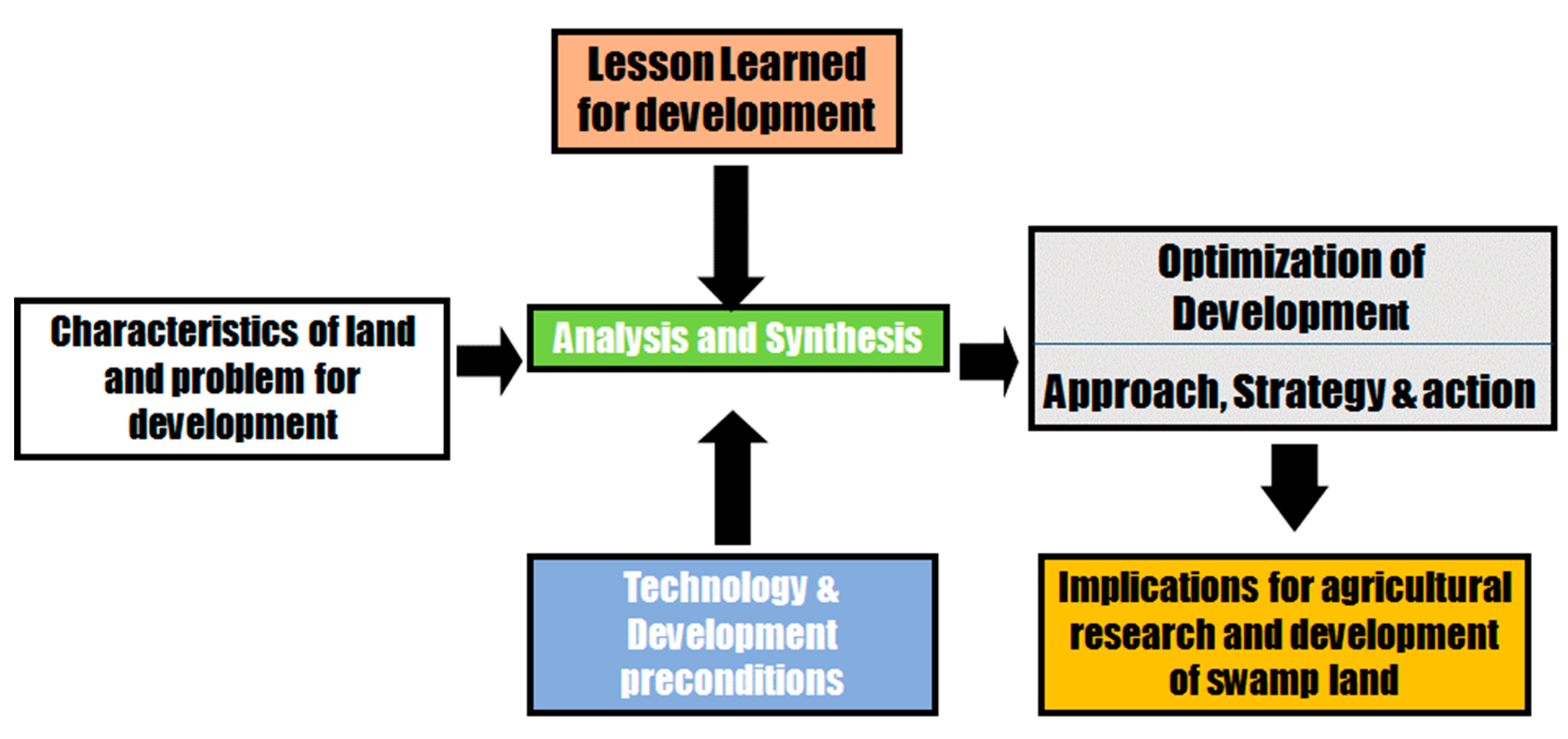

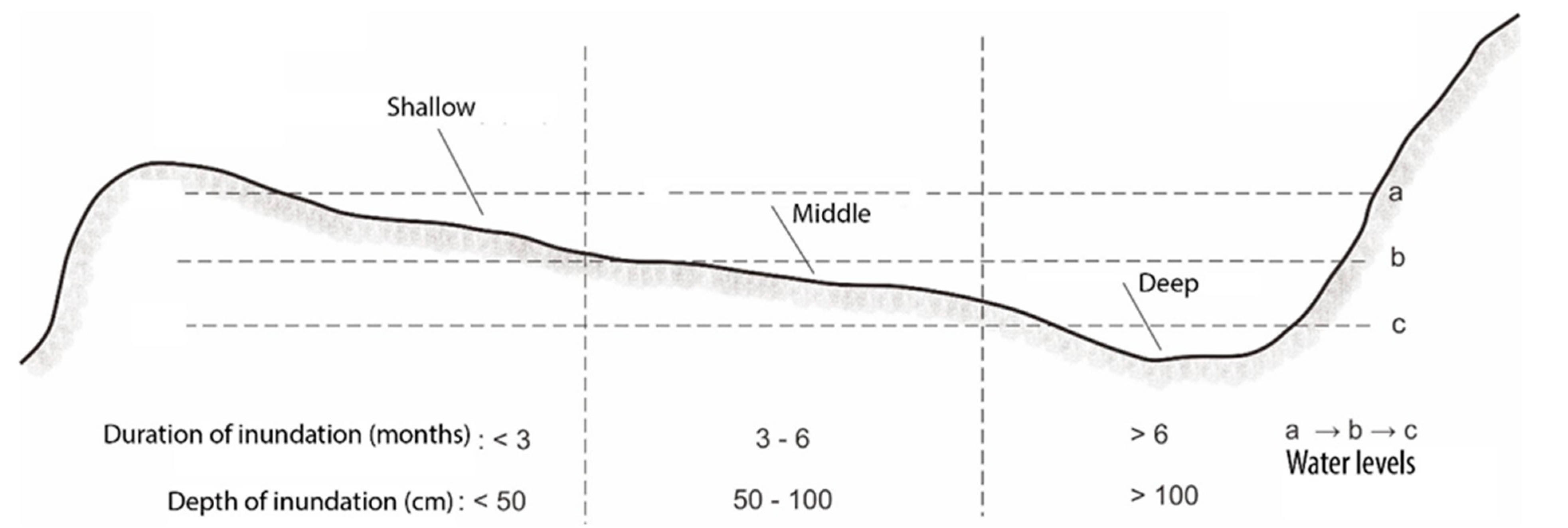
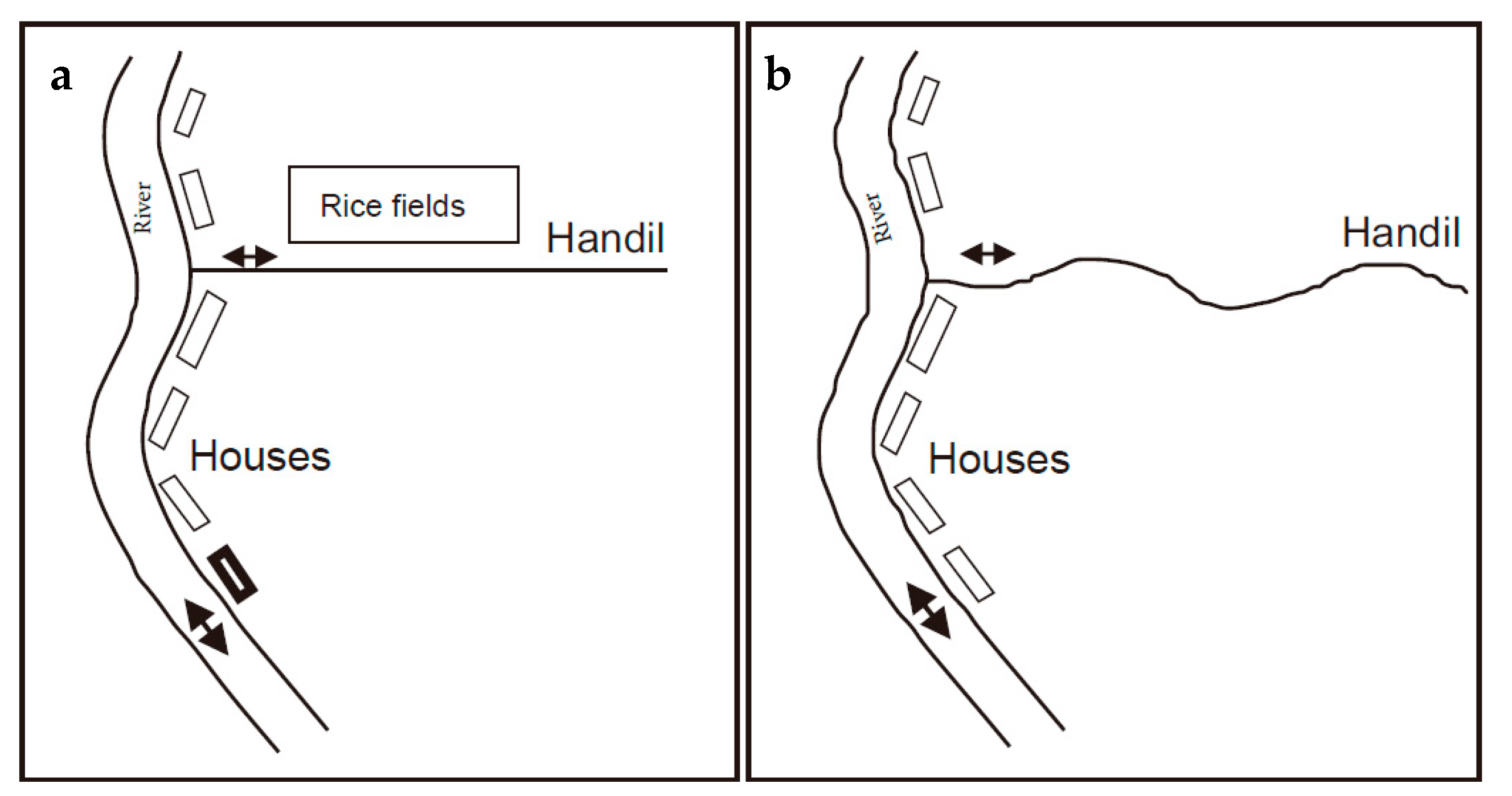
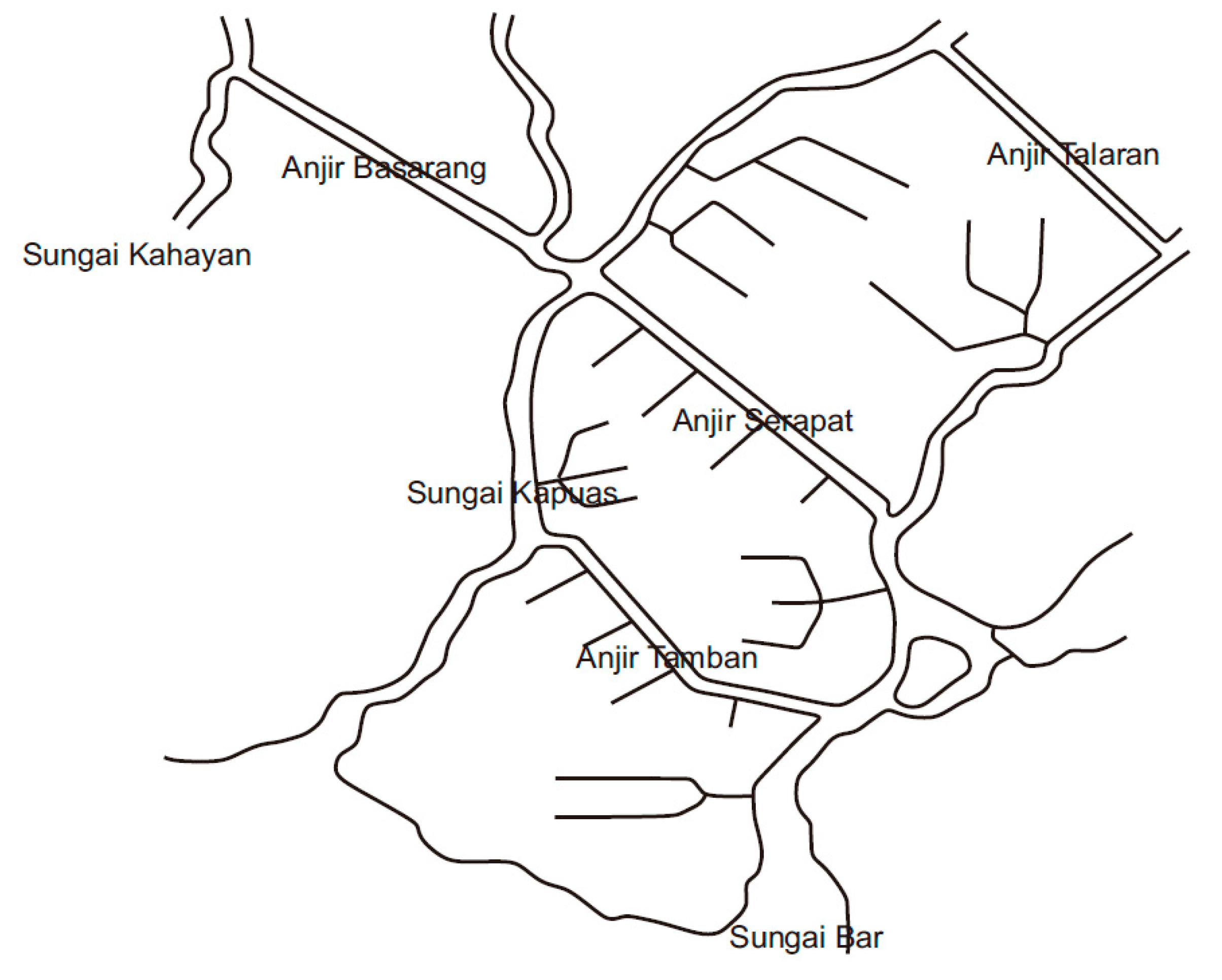
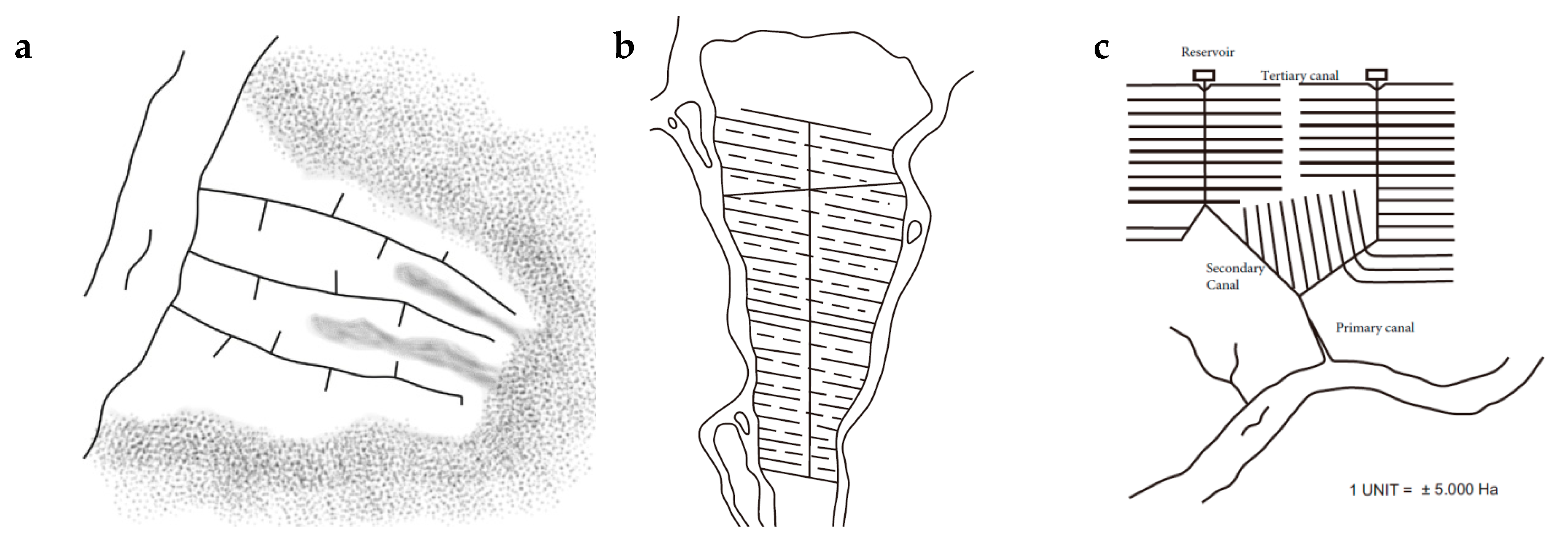
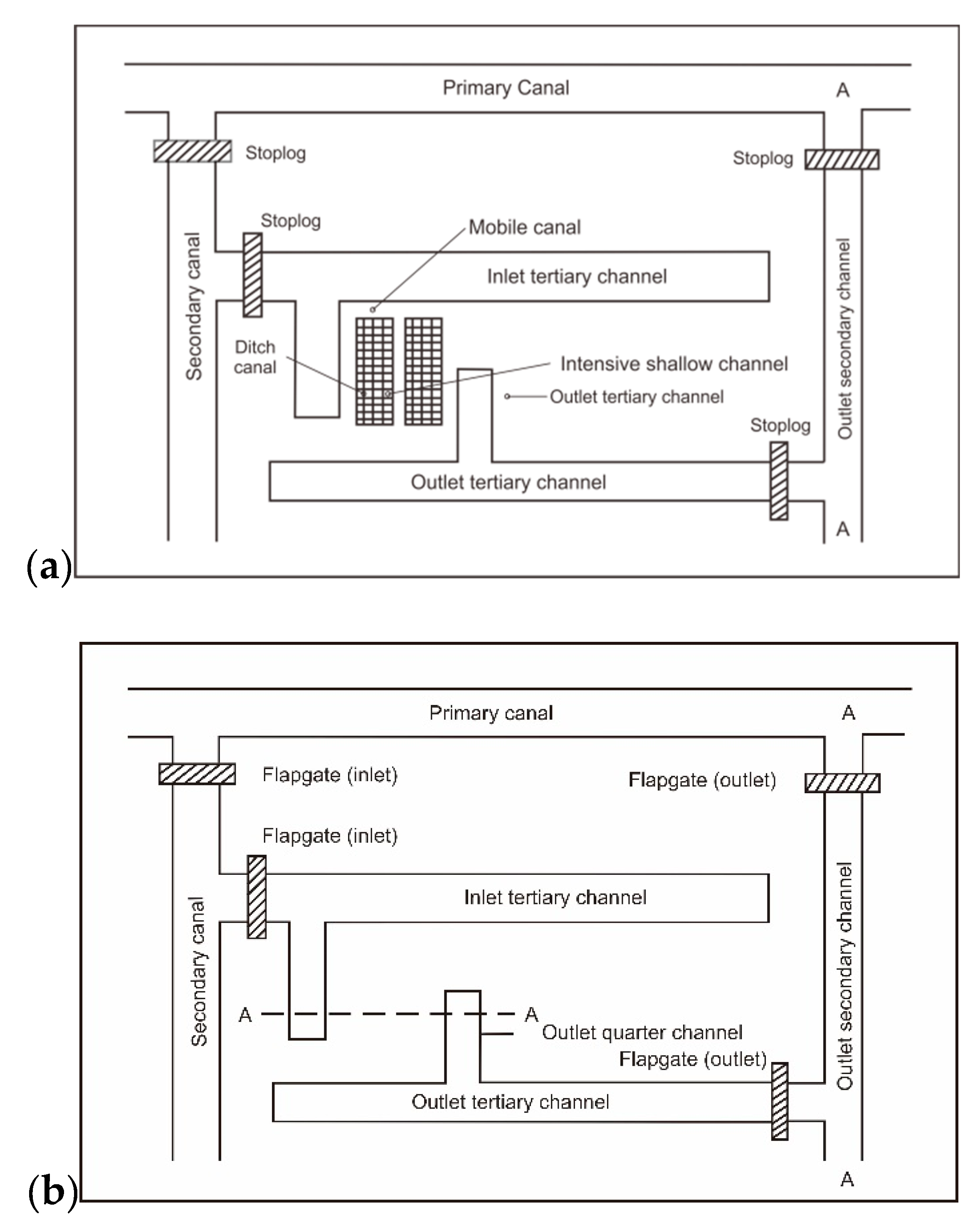

| Island | Type | Total | |
|---|---|---|---|
| Tidal Swamp | Non-Tidal Swamp | ||
| Sumatra | 3.02 | 9.91 | 12.93 |
| Jawa | 0.09 | - | 0.09 |
| Kalimantan | 2.99 | 7.04 | 10.02 |
| Sulawesi | 0.32 | 0.73 | 1.05 |
| Maluku | 0.07 | 0.09 | 0.16 |
| Papua | 2.43 | 7.44 | 9.87 |
| Indonesia | 8.92 | 25.20 | 34.12 |
| Island | Availability for (Mha) | Total (Mha) | ||
|---|---|---|---|---|
| Flooded/Paddy Rice | Horticultural Crops | Perennial Crops | ||
| Sumatera | 1.66 | 0.34 | 0.27 | 2.26 |
| Kalimantan | 0.85 | 0.53 | 0.48 | 1,85 |
| Sulawesi | 0.06 | - | - | 0.06 |
| Maluku | 0.08 | - | - | 0.08 |
| Papua | 2.47 | 0.60 | 0.19 | 3.26 |
| Indonesia | 5.12 | 1.47 | 0.93 | 7.52 |
| No. | Period of Development/Years | Areas Reclaimed (ha) | Transmigration (No. of Households) | |
|---|---|---|---|---|
| Government Sponsored | Voluntary | |||
| 1 | Pelita I (1969–1973) | 59,907 | 46,286 | - |
| 2 | Pelita II (1974–1978) | 268,997 | 84,639 | - |
| 3 | Pelita III (1979–1983) | 418,003 | 364,977 | 169,497 |
| 4 | Pelita IV (1984–1989) | 98,998 | 502,221 | - |
| 5 | Pelita V (1990–1994) | 54,088 | 180,000 | 370,000 |
| - | Total | 900,000 | 1,178,113 | 539,497 |
© 2019 by the authors. Licensee MDPI, Basel, Switzerland. This article is an open access article distributed under the terms and conditions of the Creative Commons Attribution (CC BY) license (http://creativecommons.org/licenses/by/4.0/).
Share and Cite
Sulaiman, A.A.; Sulaeman, Y.; Minasny, B. A Framework for the Development of Wetland for Agricultural Use in Indonesia. Resources 2019, 8, 34. https://doi.org/10.3390/resources8010034
Sulaiman AA, Sulaeman Y, Minasny B. A Framework for the Development of Wetland for Agricultural Use in Indonesia. Resources. 2019; 8(1):34. https://doi.org/10.3390/resources8010034
Chicago/Turabian StyleSulaiman, Andi Amran, Yiyi Sulaeman, and Budiman Minasny. 2019. "A Framework for the Development of Wetland for Agricultural Use in Indonesia" Resources 8, no. 1: 34. https://doi.org/10.3390/resources8010034
APA StyleSulaiman, A. A., Sulaeman, Y., & Minasny, B. (2019). A Framework for the Development of Wetland for Agricultural Use in Indonesia. Resources, 8(1), 34. https://doi.org/10.3390/resources8010034





